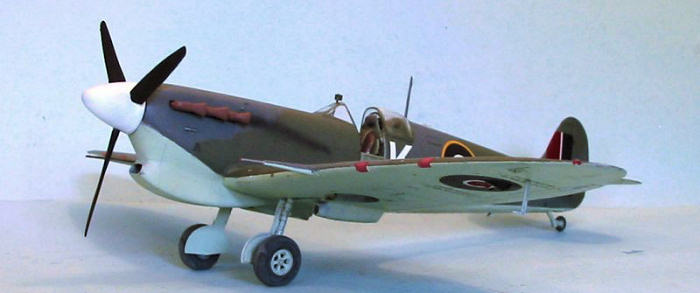
Hasegawa 1/32 Seafire Ib conversion
| KIT #: | ? |
| PRICE: | $44.95 MSRP for the Spit Vb kit |
| DECALS: | Two Options |
| REVIEWER: | Tom Cleaver |
| NOTES: | Conversion |

| HISTORY |
If ever there was an airplane that did not belong on the deck of an aircraft carrier, that airplane was the Supermarine Spitfire, a delicate, lightweight airplane entirely unsuited to the strenuous demands of surviving a “controlled crash” that is the essence of operating from an aircraft carrier. This fact was borne out by the loss rates.
Unfortunately, at the outset of the war the Royal Navy had no
designed-for-the-purpose carrier-based fighter aircraft capable of meeting a
land-based fighter on anything approaching equal terms, and this situation
remained throughout the war as regarded native-British designs. The result was
the acceptance though force majeure of the Supermarine Seafire, or Sea Spitfire
(the official name), which was a naval development of the Spitfire, and the
second modern carrier based fighter fielded by the Royal Navy (the
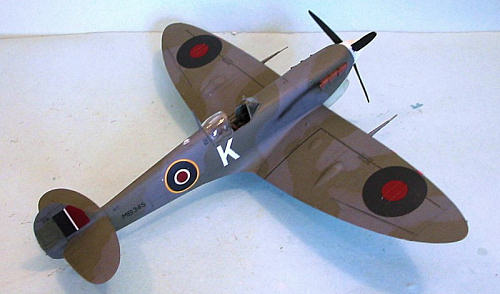 first being a naval adaptation of
the Hawker Hurricane). The Seafire differed from the land-based Spitfire by the
incorporation of an arrester hook, attachments for catapult use, and on later
variants, folding wings.
first being a naval adaptation of
the Hawker Hurricane). The Seafire differed from the land-based Spitfire by the
incorporation of an arrester hook, attachments for catapult use, and on later
variants, folding wings.
The Seafire was far from the ideal carrier fighter. Landings were especially difficult and far more Seafires were lost through operational accidents than ever fell to enemy fire. However, its performance outweighed the disadvantages. The Seafire’s fast climb and maneuverability made it a very good Fleet defense fighter.
Supermarine first approached the Admiralty in 1938 with a specifically designed naval version of the Spitfire. However, the Admiralty ordered the Fairey Fulmar as the new fleet defense fighter of the Fleet Air Arm.
Finally, in September 1941, the Admiralty placed an order for 250 navalized Spitfire Mk V aircraft. The modifications of the Spitfire did change the characteristics of the Seafire. Approaches were difficult, visibility was limited at best, landing gear collapses were commonplace, and, the arrester hooks had a tendency to miss and bounce back into the fuselage which buckled the airframe. As a low-level fleet defense interceptor, the Seafire was supreme, but it paid a price with its fragility.
Eventually 163 ex-RAF Spitfire Mk. Vb’s were converted to the Seafire Mk Ib standard with arrester hooks, strengthened rear fuselages, slinging points, and Naval radios.
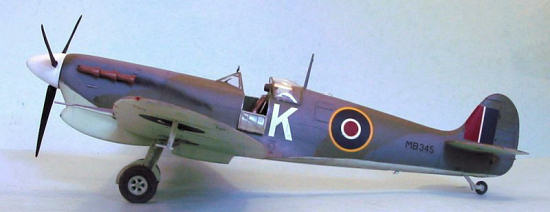 The first major operation
in which Seafires participated was Operation Torch in North Africa, in November
1942. This was followed in July 1943 by Operation Husky in Sicily, which
demonstrated just how fragile the Seafire was. Of the 106 deployed, 58 were
destroyed or rendered unserviceable during the first 48 hours as the result of
landing accidents, while only 23 were serviceable when the operation concluded.
The first major operation
in which Seafires participated was Operation Torch in North Africa, in November
1942. This was followed in July 1943 by Operation Husky in Sicily, which
demonstrated just how fragile the Seafire was. Of the 106 deployed, 58 were
destroyed or rendered unserviceable during the first 48 hours as the result of
landing accidents, while only 23 were serviceable when the operation concluded.
A Seafire from 801 Squadron, which was the first Seafire squadron to enter action aboard HMS Furious during Operation Torch in November 1942 shot down a Dewoitine D.520 for the Seafire’s first victory.
The Seafire first proved itself completely during the landings at Salerno in September 1943, where the six Seafire squadrons aboard four carriers provided the only on-scene fighter cover for the invasion, which was too distant for fighters based on Sicily to cover the fleet for an appreciable patrol time. Still, in only five days of operations, the Fleet Air Arm lost 60 Seafires, mostly due again to carrier landing accidents.
| THE KIT |
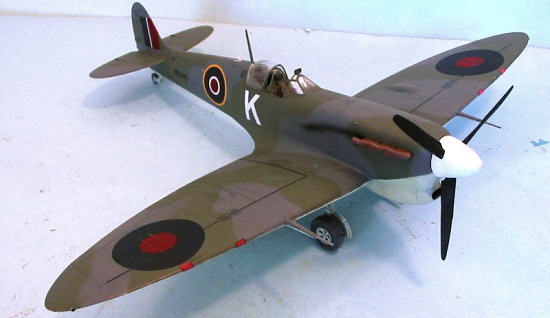 Hasegawa’s Spitfire Vb has
been released several times over the past nearly-30 years, most recently as a
Spitfire IIb. While this most recent release of the kit as a Spitfire II
provides the starter bulge that is the primary visual clue one is looking at a
Spitfire II and not a Spitfire I or V, the kit still has metal ailerons that
would have to be modified to fabric-covered ailerons to create an accurate
Spitfire II - unless one was doing an aircraft operated by Douglas Bader’s
Tangmere Wing in 1941, and then one would have to change it from a cannon-armed
Spitfire IIb to an all-machine gun armed Spitfire IIa. In fact, the two
airplanes for which markings are provided in the kit are actually Spitfire IIa’s,
since not too many Spitfire IIb’s saw operations.
Hasegawa’s Spitfire Vb has
been released several times over the past nearly-30 years, most recently as a
Spitfire IIb. While this most recent release of the kit as a Spitfire II
provides the starter bulge that is the primary visual clue one is looking at a
Spitfire II and not a Spitfire I or V, the kit still has metal ailerons that
would have to be modified to fabric-covered ailerons to create an accurate
Spitfire II - unless one was doing an aircraft operated by Douglas Bader’s
Tangmere Wing in 1941, and then one would have to change it from a cannon-armed
Spitfire IIb to an all-machine gun armed Spitfire IIa. In fact, the two
airplanes for which markings are provided in the kit are actually Spitfire IIa’s,
since not too many Spitfire IIb’s saw operations.
While the kit has raised-line panel detail, it is quite accurate in outline and dimensions, with good fabric effect on the rudder and elevators. The cockpit has adequate detail, though the seat does not have the padded back. Both the early and late windscreens are provided. Past that, the kit has all the strengths and weaknesses that have been associated with it over the years.
| CONSTRUCTION |
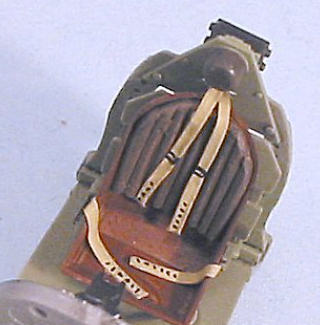 Construction was really
quite simple. I have been very surprised by the fit of these 1970s-era Hasegawa
1/32 kits like this, the Zero, the P-12 and the P-26, all of which go together
much easier than Hasegawa’s 1/48 and 1/72 kits from the same period.
Construction was really
quite simple. I have been very surprised by the fit of these 1970s-era Hasegawa
1/32 kits like this, the Zero, the P-12 and the P-26, all of which go together
much easier than Hasegawa’s 1/48 and 1/72 kits from the same period.
I used some Evergreen dowel to create the ribbed leather back pad for the seat, which was the only modification I did to the kit other than to rescribe panel detail. I also made seatbelts from lead foil taken from a wine bottle.
Assembly was straightforward, though I needed to fill large sink areas on bother upper wing parts where the lower flap caused shrinkage in the mold. Other than that, I only needed Mr. Surfacer on the fuselage centerline seam and the upper wing-to-fuselage joint.
The big difference between this and the Spitfire Vb I made was that I used the large Vokes filter for this, to make a Seafire Ib from 802 Squadron aboard HMS Furious, as seen in a well-known photograph.
I cut a hole in the lower rear fuselage, where I put a scratchbuilt arrester hook. I scribed in the section of the A-frame that was flush with the fuselage when the hook was retracted.
| COLORS & MARKINGS |
Painting:
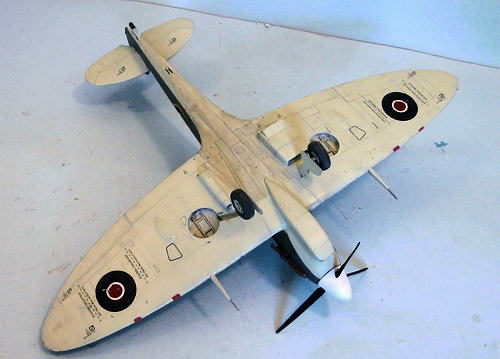 I used Xtracrylix Dark Sea
Grey, Dark Slate Grey, and Sky to do the FAA Sea Scheme, which was freehanded
with my Paasche-H airbrush. When the paint was fully cured, I gave the model a
coat of Future.
I used Xtracrylix Dark Sea
Grey, Dark Slate Grey, and Sky to do the FAA Sea Scheme, which was freehanded
with my Paasche-H airbrush. When the paint was fully cured, I gave the model a
coat of Future.
Decals:
I used the kit national markings decals, a “K” and the “Royal Navy” markings out of the decal dungeon, and a serial number pieced together from a decal sheet of RAF numbers and letters. I also used the stenciling decals from the kit sheet.
| FINAL CONSTRUCTION |
The photograph I was using as a guide only showed some exhaust staining on the airplanes. Naval aircraft don’t have a lot of “natural metal dings” because salt water corrodes aluminum. Also, these airplanes likely didn’t last long enough to amass a lot of weathering.
| CONCLUSIONS |
This is a very simple conversion of the standard kit. Going to the trouble of modifying the wings from a “b” to a “c” wing to do a Seafire IIc or Seafire III was more trouble than I wanted to go through.
August 2006
Copyright ModelingMadness.com
Kit courtesy of my wallet.
If you would like your product reviewed fairly and fairly quickly, please contact the editor or see other details in the Note to Contributors.
Back to the Review Index Page 2017